Guide to Shark Identification
Order Orectolobiformes —
Carpet Sharks
The carpet sharks are a diverse group inhabiting coral and rocky reefs, with the greatest species richness occurring in the Indo-West Pacific region. Many species are attractively patterned. All orectoloboids share the following characteristics:
 mouth completely in front of eyes
mouth completely in front of eyes- both dorsal fins without spines
- five pairs of gill slits
- anal fin present

Key to selected orectoloboid
families
Rhicodontidae |
Stegostomatidae | Orectolobidae |
Hemiscylliidae |
Ginglymostomatidae
Family Orectolobidae — Wobbegongs
Wobbegongs are strange sharks restricted to Australian and Southeast Asian waters and feature the following characteristics:
- body flattened and paddle-shaped, with broad pectoral and pelvic fins
- no dermal ridges along back
- fleshy dermal flaps around margin of head
- mouth broad and completely anterior to eyes
- large, crescent-shaped spiracle behind each eye
- both dorsal fins similar in size, the first originating over rear base of the pelvic fins
- origin of anal fin well behind origin of second dorsal fin
- caudal fin much shorter than rest of shark, almost parallel to body axis and with weakly developed lower lobe
Tassled Wobbegong (Eucrossorhinus dasypogon)
What to Look For:
- profuse, highly branched dermal flaps around margin of head
- body and fins covered with reticulated pattern of dark lines on light background
- range restricted to northern Australia and New Guinea
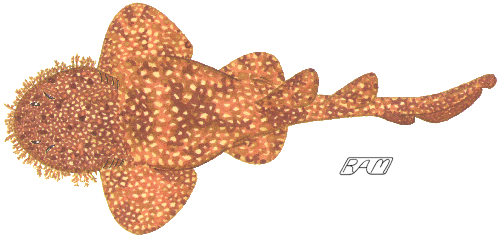
Size: average length 2 to 3 feet (60 to 100 centimetres), maximum 4 feet (1.2 metres)
Habitat: Intertidal, Coral Reefs
Distribution: Northern Australian
Spotted Wobbegong (Orectolobus maculatus)
What to Look For:
- relatively few, branched dermal flaps around margin of head
- body and fins with a somber variegated pattern featuring obscure dark saddles on the back and densely covered with pale ring-shaped markings
- dark triangular mark between eyes
- range restricted to Australia and Southeast Asia, from the South China Sea and Japan
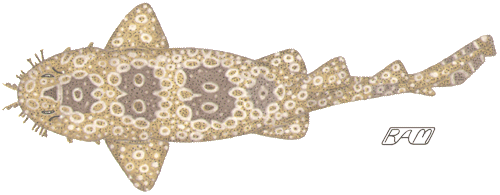
Size: average length 5 to 6 feet (1.5 to 1.8 metres), maximum 10.5 feet (3.2 metres)
Habitat: Estuaries, Sandy Plains, Rocky Reefs, Coral Reefs
Distribution: ?Southeast Asian, Western Australian, Southeastern Australian/New Zealand, Northern Australian, ?Japanese
Ecological profile of the Spotted Wobbegong
Ornate Wobbegong (Orectolobus ornatus)
What to Look For:
- relatively few, lobate dermal flaps around margin of head
- body and fins with a conspicuous variegated pattern densely covered with light spots and featuring distinct dark saddles with black, corrugated margins interspersed with paler areas on the back
- no dark triangular mark between eyes
- range restricted to Australia, New Guinea, and Japan
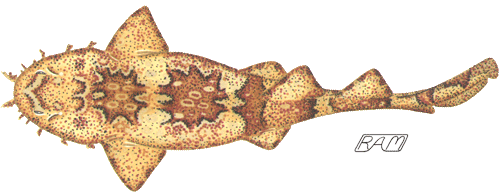
Size: average length 2 to 5 feet (0.6 to 1.5 metres), maximum 10 feet (2.9 metres)
Habitat: Rocky Reefs, Coral Reefs
Distribution: Southeast Asian, Western Australian, Southeastern Australian/New Zealand, Northern Australian, Japanese
Family Hemiscylliidae — Bamboo Sharks
Bamboo sharks are delicate little creatures inhabiting coral reefs in the Indo-West Pacific region. All hemiscylliids share the following characteristics:
- body elongate and slender
 both dorsal fins similar in size, the first originating
behind the pelvic fins
both dorsal fins similar in size, the first originating
behind the pelvic fins - mouth small
- prominent lobe and groove around outer edge of each nostril
- conspicuous circular spiracle below behind each eye
- origin of anal fin well behind origin of second dorsal fin, almost appearing to be part of the caudal fin
Epaulette Shark (Hemiscyllium ocellatum)
What to Look For:
- a large black ocellus, ringed with white but not surrounded by black spots, above and behind the base of each pectoral fin; head, flanks and fins with indistinct saddles and scattered large dark spots
- range restricted to northern Australia and New Guinea

Size: averages length about 24 inches (60 centimetres), maximum 42 inches (107 centimetres)
Habitat: Intertidal, Coral Reefs
Distribution: Western Australian, ?Southeastern Australian/New Zealand, Northern Australian
Ecological profile of the Epaulette Shark
Family Ginglymostomatidae — Nurse Sharks
Nurse sharks are bottom-loving creatures most commonly associated with coral reef habitats. All ginglymostomatids share the following features:
- moderately long, catfish-like nasal barbels
 mouth small and connected to base of nasal barbels via
nasoral groove
mouth small and connected to base of nasal barbels via
nasoral groove- no lobe and groove around outer edge of each nostril
- fourth and fifth gill slits very close together
- spiracle tiny, located below and behind the eye
Nurse Shark (Ginglymostoma cirratum)
What to Look For:
- dorsal fins broadly rounded, pectoral fins broadly rounded and non-falcate
- first dorsal fin obviously larger than second dorsal and anal fins, originating over the pelvic fins
- origin of anal fin well behind origin of second dorsal fin
- juveniles with obscure saddle markings on back and peppered with small dark spots
- range limited to eastern Pacific, from Baja to Peru, western and eastern North Atlantic, from Rhode Island to southern Brazil and western Africa, respectively
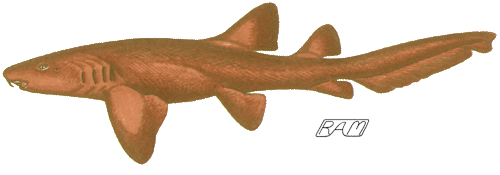
Size: average length 5 to 7 feet (1.5 to 2.3 metres), maximum to 9 feet (2.8 metres)
Habitat: Intertidal, Estuaries, Sandy Plains, Rocky Reefs, Coral Reefs
Distribution: Tropical Eastern Pacific, Chilean, Argentinean, Amazonian, Caribbean, Western North Atlantic, ?Eastern North Atlantic/Mediterranean, West African, ?Southern African
Ecological profile of the Nurse Shark
Tawny Nurse Shark (Nebrius ferrugineus)
What to Look For:
- dorsal fins angular with pointed apices, pectoral fins falcate
- first dorsal fin slightly larger than second dorsal and anal fins, originating over the pelvic fins
- origin of anal fin slightly behind origin of second dorsal fin
- range limited to Indo-West Pacific region, from scattered locales in French Polynesia and Micronesia, northern Australia and New Guinea, through Indonesia and warmer parts of Southeast Asia, India, around the Arabian Peninsula, off eastern Africa and Madagascar

Size: average length about 7 feet (2.3 metres), maximum 10.5 feet (3.2 metres)
Habitat: Intertidal, Sandy Plains, Coral Reefs
Distribution: Central Pacific, Madagascaran, Arabian, Indian, Southeast Asian, Northern Australian
Family Stegostomatidae — Zebra Shark
The highly distinctive Zebra Shark is the sole representative of its family, whose characteristics (as given below) can be considered the same as those for its only species.
Zebra Shark (Stegostoma fasciatum)
What to Look For:
- caudal fin about as long as rest of the shark, broad with weakly developed lower love and almost parallel with body axis
- prominent dermal ridges along body, extending from above the gill slits to base of the caudal fin but not forming lateral keels on the tail stalk
- short nasal barbels
- mouth small and connected to base of nasal barbels via nasoral groove
- fourth and fifth gill slits very close together
- spiracle larger than eye, located behind it
- dorsal fins triangular with pointed apices, pectoral fins broadly rounded and paddle-like
- first dorsal fin originating completely behind the pelvic fins
- origin of anal fin completely behind base of second dorsal fin
- individuals less than 20 inches (50 centimetres) long are dark brown above with narrow, yellowish zebra-like bars and spots breaking back and flanks into dark saddles; between 20 and 35 inches (50 and 90 centimetres), these saddles break up into small brown spots on a yellow background, becoming less linear and more uniformly distributed with further growth

Size: average length 5 to 7 feet (1.5 to 2.3 metres), maximum to 11.5 feet (3.5 metres)
Habitat: Rocky Reefs, Coral Reefs
Distribution: Southern African, Madagascaran, Arabian, Indian, Southeast Asian, Western Australian, Southeastern Australian/New Zealand, Northern Australian, Japanese
Ecological profile of the Zebra Shark
Family Rhincodontidae — Whale Shark
The highly distinctive Whale Shark is the sole representative of its family, whose characteristics (as given below) can be considered the same as those for its only species.
Whale Shark (Rhincodon typus)
What to Look For:
- broad, nearly terminal mouth
- prominent dermal ridges along body, extending from above the gill slits to base of the caudal fin, the lowest forming strong lateral keels on the tail stalk
- very short nasal barbels
- gill slits very large, the fourth and fifth well separated
- dorsal fins angular with pointed apices, pectoral fins broadly and falcate
- first dorsal fin originating anterior to the pelvic fins
- origin of anal fin under that of second dorsal fin
- caudal fin erect and semilunate, with well developed lower lobe and lacking a subterminal notch
- unique pigmentation pattern of dark background sprinkled with irregular pale spots, the back and flanks divided into orderly ‘checkerboard’ pattern of pale vertical bars and large polkadots, and undersurfaces white
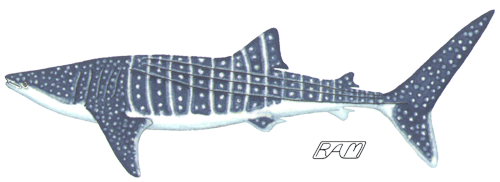
Size: average length 23 to 35 feet (7 to 10.5 metres), maximum to at least 45 feet (13 metres).
Habitat: Rocky Reefs, Coral Reefs, Open Ocean, Deep Sea
Distribution: Central Pacific, Tropical Eastern Pacific, Argentinean, Amazonian, Caribbean, Western North Atlantic, West African, Southern African, Central Indian, Madagascaran, Arabian, Indian, Southeast Asian, Western Australian, Northern Australian, Japanese
